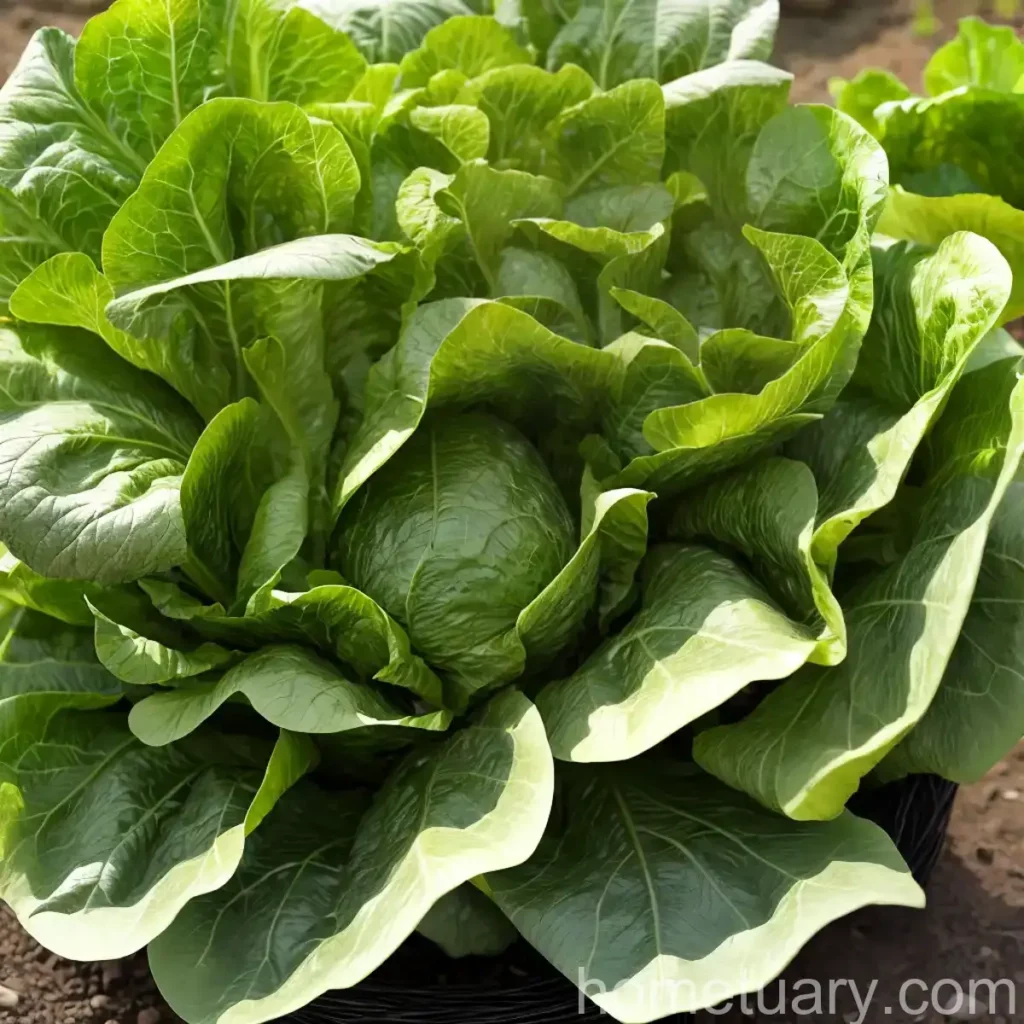Lettuce (Lactuca sativa ‘Merlot’)
Lettuce (Lactuca sativa ‘Merlot’) is a popular leafy green that is widely cultivated for its crisp and flavorful leaves. This article will dive into the culture, uses, care, and propagation of lettuce (Lactuca sativa ‘Merlot’). We will explore its water, sunlight, fertilizer, soil, pruning, propagation, container gardening, popularity, common diseases, and pests. Additionally, we will provide valuable botanist’s tips, fun facts, and links to external resources.
What is Lettuce (Lactuca sativa ‘Merlot’)?
Lettuce (Lactuca sativa) is a leafy green plant cultivated as a vegetable. It is a member of the Asteraceae family and is most often used in salads, sandwiches, and wraps. The ‘Merlot’ variety, in particular, is known for its deep red leaves and excellent flavor, making it a popular choice for both commercial and home gardeners.
Key Takeaways – Lettuce (Lactuca sativa ‘Merlot’)
Before we dive into the specifics of lettuce (Lactuca sativa ‘Merlot’), let’s quickly overview some key takeaways about this wonderful plant:
- Scientific Name: Lactuca sativa ‘Merlot’
- Category: Leafy green vegetable
- Cultivar: ‘Merlot’
- Uses: Consumed in salads, sandwiches, and wraps
- Characteristics: Deep red leaves, crisp and flavorful taste
- Cultivation: Widely grown in gardens, farms, and greenhouses
- Popularity: Popular for its unique color and taste
- Propagation: Can be grown from seeds or seedlings
Now that we have an overview of lettuce (Lactuca sativa ‘Merlot’), let’s delve into its specific cultural requirements and uses.
Culture
Cultural practices play a vital role in the successful growth and development of lettuce (Lactuca sativa ‘Merlot’). This section will cover the water, sunlight, fertilizer, soil, and pruning requirements for cultivating this variety of lettuce.
Water
Providing adequate water is essential for the healthy growth of lettuce. The ‘Merlot’ variety requires consistent moisture to thrive, but it is essential to avoid waterlogging the soil. Proper watering ensures the development of crisp and flavorful leaves.
Recommended Watering Practices:
– Frequency: Water regularly, ensuring that the soil is consistently moist but not waterlogged.
– Method: Use a watering can or garden hose to apply water directly to the soil, avoiding wetting the leaves to minimize the risk of disease.
– Time of Day: Water in the early morning to allow excess moisture to evaporate during the day, reducing the risk of fungal diseases.
Sunlight
Lettuce (Lactuca sativa ‘Merlot’) thrives in cooler temperatures and partial shade. While it requires some sunlight for healthy growth, it is crucial to protect it from intense midday sun, especially in warmer climates.
Optimal Sunlight Conditions:
– Exposure: Choose a location with partial shade, especially in the afternoon.
– Duration: Aim for at least 4-6 hours of sunlight daily, but avoid prolonged exposure to intense midday sun.
Fertilizer
Proper fertilization is key to maximizing the growth and flavor of ‘Merlot’ lettuce. Organic matter and balanced fertilizers can help provide essential nutrients for vibrant and healthy leaves.
Fertilization Guidelines:
– Type: Use a balanced fertilizer, or incorporate well-rotted compost into the soil before planting.
– Timing: Apply fertilizer when planting and side-dress with a balanced fertilizer during the growing season.
– Application: Follow the package instructions for the appropriate application rates and methods.
Soil
Lettuce (Lactuca sativa ‘Merlot’) grows best in well-draining, fertile soil with a slightly acidic to neutral pH. It is important to prepare the soil adequately before planting to ensure optimal growing conditions.
Recommended Soil Conditions:
– Texture: Choose a loamy soil that offers good drainage while retaining moisture.
– pH Level: Aim for a slightly acidic to neutral pH range of 6.0-7.0 for optimal nutrient uptake.
– Preparation: Amend the soil with organic matter such as compost to improve its fertility and structure.
Pruning
Pruning or thinning lettuce plants can promote better air circulation, reduce competition for nutrients, and prevent overcrowding, which can lead to disease and poor growth.
Pruning Practices:
– Thinning: Thin out overcrowded seedlings to maintain proper spacing, typically 6-12 inches apart, depending on the variety.
– Harvesting: Harvest outer leaves regularly to encourage continuous growth and to prevent the plant from bolting prematurely.
Now that we have covered the cultural practices for growing lettuce (Lactuca sativa ‘Merlot’), let’s explore its various uses and benefits.
Uses
Lettuce (Lactuca sativa ‘Merlot’) is a versatile and popular leafy green that offers various culinary uses and health benefits. From salads to sandwiches, its vibrant color and crisp texture add both visual appeal and a refreshing taste to dishes.
Culinary Uses
The rich, red color and crisp texture of ‘Merlot’ lettuce make it an excellent addition to a wide range of culinary creations. Its uses extend beyond the typical salad, enriching a variety of dishes with its unique flavor and visual appeal.
Popular Culinary Applications:
– Salads: ‘Merlot’ lettuce can be used as the base or as a colorful addition to various salad combinations, adding texture and visual interest.
– Wraps: Its large, crisp leaves make ‘Merlot’ lettuce an ideal choice for wrapping fillings, adding a delightful crunch to the dish.
– Sandwiches: From burgers to classic deli-style creations, the vibrant hue and refreshing taste of ‘Merlot’ lettuce enhance the appeal of sandwiches.
Health Benefits
In addition to its culinary versatility, lettuce (Lactuca sativa ‘Merlot’) offers various health benefits. As a leafy green vegetable, it is a good source of essential nutrients and contributes to overall well-being.
Nutritional Highlights:
– Vitamins: Lettuce is rich in vitamins A and K, offering antioxidant and bone-strengthening benefits.
– Hydration: With its high water content, lettuce contributes to overall hydration and supports healthy digestion.
– Low in Calories: It is a low-calorie food, making it a great choice for those seeking to manage their weight.
The diverse uses and nutritional benefits of ‘Merlot’ lettuce contribute to its popularity among home cooks and chefs alike. Now, let’s delve into the specific care requirements for growing this variety of lettuce.
Water
Lettuce (Lactuca sativa ‘Merlot’) thrives in cool, moist conditions and is sensitive to drought. When it comes to watering this leafy green, consistency and proper techniques are key to ensuring its health and productivity.
Sunlight
Though lettuce (Lactuca sativa ‘Merlot’) prefers cooler temperatures and partial shade, it requires an appropriate amount of sunlight to support its growth and development. Understanding its sunlight preferences is essential for successful cultivation.
Fertilizer
Proper fertilization is crucial for optimizing the growth and flavor of ‘Merlot’ lettuce. By understanding the nutritional needs and fertilization guidelines, gardeners can promote healthy and robust plants.
Soil
The quality of the soil directly impacts the growth and yield of lettuce (Lactuca sativa ‘Merlot’). By creating an optimal soil environment and understanding the specific soil preferences of this variety, gardeners can set the stage for a successful harvest.
Pruning
Pruning or thinning lettuce plants is essential to maintain airflow, prevent overcrowding, and encourage healthy growth. Understanding the principles of pruning can help gardeners promote the well-being of ‘Merlot’ lettuce plants.
Propagation
Lettuce (Lactuca sativa ‘Merlot’) can be propagated from seeds or seedlings. By following appropriate methods and providing the right growing conditions, gardeners can successfully propagate ‘Merlot’ lettuce in their gardens.
Container Gardening
Container gardening offers a convenient and versatile way to grow ‘Merlot’ lettuce, especially for those with limited space. Understanding the specific requirements and considerations for container cultivation is key to success.
Popularity
The ‘Merlot’ variety of lettuce is known for its unique deep red color and excellent flavor, making it a popular choice among vegetable gardeners and culinary enthusiasts. Its popularity stems from its vibrant appearance and versatility in the kitchen.
Common Diseases
Lettuce (Lactuca sativa ‘Merlot’) is susceptible to several diseases that can affect its growth and overall health. By identifying and understanding common diseases, gardeners can take preventive measures to protect their crops.
Disease Diagnosis
Identifying diseases in lettuce (Lactuca sativa ‘Merlot’) requires an understanding of the symptoms and signs associated with various pathogens and environmental conditions. Accurate diagnosis is crucial for implementing effective disease management strategies.
Common Pests
Pests can pose a significant threat to the health and yield of lettuce (Lactuca sativa ‘Merlot’). Being able to recognize and address common pests is essential for protecting the crop and ensuring successful cultivation.
Botanist’s Tips
Seasoned botanists offer valuable insights and tips for growing lettuce (Lactuca sativa ‘Merlot’) successfully. Their expertise equips gardeners with practical knowledge and strategies for cultivating vibrant and healthy plants.
Fun Facts
Exploring interesting and lesser-known facts about lettuce (Lactuca sativa ‘Merlot’) adds a delightful dimension to the cultivation experience and deepens appreciation for this beloved leafy green.
Links to External Resources
External resources such as reputable websites, academic articles, and gardening guides provide additional information and insights about lettuce (Lactuca sativa ‘Merlot’), offering valuable support for gardeners and enthusiasts.
Let’s journey into the world of lettuce (Lactuca sativa ‘Merlot’) as we explore its culture, uses, care, and propagation. This informative guide aims to equip both novice and experienced gardeners with the knowledge and strategies for cultivating vibrant and healthy ‘Merlot’ lettuce plants.
Keywords: Lettuce varieties, Merlot lettuce, Lactuca sativa, leafy greens, salad greens, edible plants, vegetable gardening, growing lettuce, leafy vegetable, red lettuce, planting lettuce, lettuce cultivation, home garden lettuce, lettuce nutrition, lettuce health benefits, organic lettuce, best lettuce varieties, lettuce growing tips, lettuce care, lettuce recipes, lettuce cooking ideas, lettuce culinary uses, lettuce gardening techniques, lettuce companion plants, lettuce pests and diseases, lettuce growing in containers, lettuce seedlings, tips for harvesting lettuce, lettuce storage methods, perennial lettuce, winter lettuce, summer lettuce, hydroponic lettuce, lettuce for beginners, baby lettuce, romaine lettuce, butterhead lettuce, loose-leaf lettuce, crisphead lettuce, green lettuce varieties, red-leaf lettuce varieties, amaranth lettuce, cos lettuce, Batavia lettuce, oakleaf lettuce, Boston lettuce, iceberg lettuce, Chinese lettuce, greenhouse lettuce, lettuce varieties for different climates















